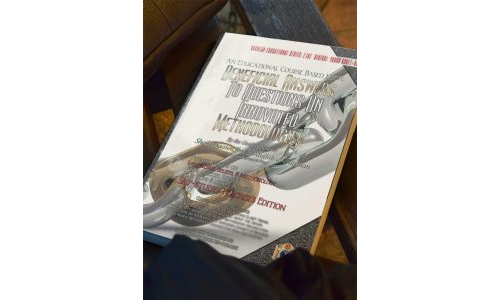A Short Clarification Regarding the Wearing of Jeans, Resembling the Disbelievers, and Clothing of Fame and Notoriety
Compiled by Umm Mujaahid Khadijah Bint Lacina
Alhamdulillah, and may His praise and salutations be upon His final prophet and messenger, Muhammad, and upon his family, companions, and those who follow them in righteousness until the Last Day. To Proceed:
This is in response to the questions asked by a sister in one of my classes, alhamdulillah, related to her reading of “My Home, My Path”. In summary, she asked concerning:
1. The ruling regarding the wearing of jeans
2. Resembling the disbelievers in our clothing
3. Wearing clothing of fame and notoriety
4. Are these things applicable in the house as well as outside, and in front of our husbands
5. Is it permissible to dress our children in such clothing when they are young
The Wearing of Jeans
When I was studying “Bulugh al-Maram” in Damaaj with Umm Salamah, may Allaah preserve her, the question of the jeans came up. Alhamdulillah, she gave a brief answer in which she stated that she felt the strongest opinion was that they were not permissible, and then told us that she was going to research the issue further, insh’Allaah. Later, she gave us a full explanation, which was added to and later published as part of her book, “al-Fatwa fee Zeenat bint Hawaa”. In it she quotes research done online by one of the French sisters who was a student of knowledge in Damaaj at the time, Umm Bilaal. It becomes clear from the research that the jeans are something that would be considered a distinguishing symbol for American culture, mash’Allaah. After discussing this, Umm Salamah says,
“…who can think that the reason the young and old people in the cities wear jeans is because of their appropriateness for hard work?!? Rather, it is a distinguishing symbol. And if one had to choose the types of clothes that became prominent in the twentieth century there is no doubt at all that jeans would be the first thing on the list. Jeans have been the fashion for a whole century…
…and after this, and before we mention the ruling of this type of clothing, we should read what Sheikh Muhammad Naasir ad-Deen al-Albaani, may Allaah have mercy upon him, said, concerning the criterion of resembling the disbelievers. He said,
“I say that the criterion concerning resembling the disbelievers is in reality two separate principles. One of them is greater in importance that the other, in my opinion. And it is obligatory upon the student of knowledge to at least know and comprehend these two principles.
The first: is that which is from the deeds of the disbelievers and has become like a distinguishing symbol or characteristic for them. And this is not permissible- to engage in it, or to use it. This is what is meant by the general saying of the Prophet, may Allaah’s praise and salutations be upon him, that {Whoever resembles a people is of them.}
The second: is what the disbelievers do which is not a distinct symbol for them, but in which we are able to distinguish ourselves from them. In this case, it is not as strongly prohibited as if it were a distinct symbol for them; in that if we do (that which is a symbol for them), we resemble them.
Rather, what we are discussing now is something which they do, but which we should do in a different manner from them, based upon a very very great hadeeth on this subject which many of the students of knowledge and some of the scholars do not place enough importance upon. And this hadeeth is the saying of the Prophet, may Allaah’s praise and salutations be upon him, {Verily the Jews and the Christians do not dye their grey hair. So distinguish yourselves from them in this.} “ (End of quote from Sheikh al-Albaani as found in “Silsilaat al-Hudaa wa an-Noor” Tape 671)
Umm Salamah goes on to say, “So what is the ruling? The answer, and Allaah is the One Who Grants Success, is that what we learn from that which the Sheikh said: that which is a distinguishing symbol of them is not allowed for the Muslim. And as we know from what we have said before, the jeans have become a distinguishing symbol and an icon and a source of pride for them (the disbelievers). And I do not think that anyone after this can say that these pants are allowed. And Allaah knows best.
However, as for garments other than these pants which are made from the same type of cloth, which is a type of cotton, then Sheikh ‘Utheimeen, may Allaah have mercy upon him, was asked,
“There is a type of cloth which has become known as “jeans” and it is made into different types of clothing for the children, both boys and girls, in different fashions and manners. And this basic cloth is worn by the disbelievers in the well-known manner of tight pants. And our question is, can this cloth be used in other ways than tight pants due to its strength and good quality- and does this enter into resembling the disbelievers?”
The answer from Sheikh ‘Utheimeen: “Resembling the disbelievers is when one resembles them in something which is specific to them collectively. So if this or any other type of cloth is used in a way which resembles the dress of the disbelievers, then it enters into resembling them. However, if it is meant that the disbelievers wear clothing made from this cloth, but the cloth is made into a different type of clothing than they wear it in, then there is no problem with this; even if they are famous and well-known for this type of cloth- as long as it is worn in a different way, then there is no problem.: (“Majmoo’at As’ila Tahtam al-Usraa al-Muslimah” by Sheikh ‘Utheimeen)
(End of quote from “al-Fatwa fee Zeenat bint Hawaa” by Umm Salamah al-Salafiyyah al-‘Abassiyyah, may Allaah preserve her, from pages 71-74)
Concerning the second category of resembling the disbelievers mentioned by Sheikh al-Albaani, may Allaah have mercy upon him, above- the example Umm Salamah gave in class was that of wearing a watch. It is most common for the disbelievers to wear it on one wrist, but it is not something which distinguishes them. However, just to be different from them, we should wear our watches on the other wrist. It is not forbidden to wear it on the same wrist, but it is recommended that we try to differ from them if possible.
Sheikh ‘Utheimeen points out the difference between wearing the “jeans” as such, and wearing other clothing made out of denim. He says that the jeans themselves are that which is a distinguishing symbol of the disbelievers- but as for other clothing that is simply made out of denim which is not specific to them collectively, then this is permissible. And Allaah knows best.
Resembling the Disbelievers
This next section is taken from “My Hijaab, My Path” Pages 86-87:
That the Women’s Clothing not Resemble the Clothing of the Disbelieving Women
This is what the wise legislation forbids us from. It is that which the Messenger of Allaah, may Allaah’s praise and salutations be upon him, was speaking of, when he said, {He who resembles a people is one of them.} (Abu Daawood, Ahmad, Sa’eed ibn Mansoor, and al-Qadaa’ee. Ibn Taymiyyah, may Allaah have mercy upon him, said, “Its chain of narrations is good.” in “al-Iqtidaa”, page 72)
Sheikh al-Islaam, Ibn Taymiyyah, may Allaah have mercy upon him, said, “The least of the conditions of this hadeeth is that it requires that resembling them is forbidden, and its apparent meaning is that it demands that the one who resembles them has disbelieved, as is found in His saying, the Most High,﴾ And if any amongst you takes them as Auliyaa’ (friends, protectors, helpers) then surely, he is one of them.﴿ -(Surat al-Maa’idah, From Ayat 51)” He (Ibn Taymiyyah, may Allaah have mercy upon him), then said, “And through this, more than one of the scholars has made it a requirement that things from the clothing of other than the Muslims are disliked.”
Muhammad ibn Harb said, “I asked Ahmad (meaning, Ahmad ibn Hanbal, may Allaah have mercy upon him) concerning Sindee shoes, and going out in them. He disliked it for the man and the woman. And he said, “If it is for the bathroom or the wudhoo, then there is no problem with it, and I dislike the sound it makes (like a cricket)” And he said, “It is from the clothing of the foreigners.”
Sa’eed ibn ‘Aamir (it is found in “at-Tabaqaat” of Ibn Sa’ad, that he is Abu Muhammad al-Basree, the abstemious one, the memorizer, who was born in 120 Hijree and died in 208 Hijree) was asked concerning it, and he said, “The Sunnah of our Messenger, may Allaah’s praise and salutations be upon him, is more beloved to us than the Sunnah of Baakahun.” And Baakahun was the ruler of India at that time. (From “al-Iqtidaa” page 84)
The prohibition of resembling them (the disbelievers) is an unrestricted prohibition. ‘Umar ibn al-Khattab, may Allaah be pleased with him, wrote to the leader of the Muslim army in Adhrabeejaan on the lack of resembling them, as he said, “Beware of the clothing and shoes of the people of shirk and the silk garment…” to the end of the hadeeth. (Narrated by Muslim)
So we are a people whom Allaah has strengthened with His correct and sound deen (religion, way of life- Islaam), and from its distinguishing characteristics is its clothing, which Allaah is pleased with for us. And the one who wishes to resemble us, then welcome, and welcome, as we are on the truth and the merit, as long as we follow the Book and the Sunnah; and those besides us are on falsehood and are mistaken, due to their distance from the Book and the Sunnah and their taking passing fancies and desires. Because of that, we do not resemble other than us.
﴾ Has not the time come for the hearts of those who believe (in the Oneness of Allaah – The worship of Allaah alone without associates) to be affected by Allaah’s Reminder (this Qur’aan), and that which has been revealed of the truth, lest they become as those who received the Scripture before (i.e. Jews and Christians), and the term was prolonged for them and so their hearts were hardened? And many of them were the rebellious, the disobedient to Allaah.﴿ -(Surah Hadeed, Ayat 16) (End of quote from “My Hijaab, My Path”)
So we see from these quotations that what is meant is that we not resemble them whether we are inside or outside our homes, as this is a general prohibition, as has been understood and explained by the scholars throughout the ages. That which is prohibited with a general prohibition extends generally to all places, and all times. For example, we know that it is prohibited to drink alcohol- and this prohibition is for whether we are at home or at a restaurant or in a park, whether we are alone or with many people, whether we are old or young. Ibn Taymiyyah, as quoted above, says that resembling them is generally forbidden, and that the one who does so could be said to have fallen into an aspect of disbelief, and we ask Allaah to protect us from this.
This also extends to the children, mash’Allaah, if we want to raise them on uprightness and love of Islaam and the Sunnah. By choosing to dress them like disbelievers, we are sending a clear message that somehow the disbelievers and their way of dress is superior to our own, mash’Allaah. So that which is impermissible in adult clothing is, generally, impermissible for children’s clothing. (Note: an exception to this, for example, is the hijaab- it is not required for little girls to wear it) There are many rulings, mash’Allaah ,concerning dressing little girls in short dresses- the scholars are unanimous in saying that it is best to accustom them to modesty from a young age. This also can cut down on many evils of different societies- we see how the small children are dressed like adults, and this may cause evil to the children from one who has a sick mind, mash’Allaah. Also, while it is permissible for women to wear more revealing clothing in front of our husbands, we should take care in what we wear in front of the children, as they learn from the examples we set, mash’Allaah.
Again, concerning this resemblance to the disbelievers, what is meant is that dress which is known specifically to be from the disbelievers collectively. So we should take care not to pay attention to their fashions and trends. Rather, it is better that we look to the clothing of the Muslims for our examples and ideas as to what we would like to wear. And Allaah knows best.
Clothing of Fame and Notoriety
There is much confusion over this category of prohibition.
Concerning this type of clothing, then here is another quote from “My Hijaab, My Path”, page 87:
That the Clothing not be Clothing of Fame or Notoriety
This is whether that which is intended is showing off its high price, or to demonstrate one’s asceticism in order to show off for others; as both of these are prohibited. As it is related from the Messenger of Allaah, may Allaah’s praise and salutations be upon him, in the hadeeth of Ibn ‘Umar, may Allaah be pleased with both him and his father, that he said, {The one who wears a garment of fame in this world, then Allaah will clothe him in a garment of humility on the Day of Resurrection then he will be set aflame in it in the Fire.} (Abu Daawood, Ibn Maajah, Ahmad, and Sheikh al-Albaani has declared it to be hasan, in “al-Hijaab” and “Saheeh Sunan Ibn Maajah”
The Esteemed Scholar ash-Shawkaani, may Allaah have mercy upon him, said, “The hadeeth is a proof for the prohibition of wearing the clothing of fame. This hadeeth is not specific to costly garments. Rather, that may also occur in the one who wears a wretched, inferior garment which differs from the people’s clothing in order to be seen by the people so they are surprised or amazed by his clothing and they believe him. Ibn Raslaan said this.
If it is worn with the intention of gaining notice or fame amongst the people, then there is no difference between the exalted garments or the humble ones, and that which is approved by the people or which differs from them, because the prohibition revolves around the fame or glory, and the significant thing is the intention, even if it does not match the reality. (“Nayl al-Awtaar”)
Ibn Taymiyyah, may Allaah have mercy upon him, said, “Seeking fame or notoriety by the clothing is something hated. And it is something that is higher than the normal clothing or lower than the normal clothing. As the Salaf used to dislike both of these things, both raising and lowering.” (“Majmoo’ al-Fataawa”)
If you read these quotations carefully, you will see that in each one, intention is mentioned. So when we are talking about wearing the clothing of fame and notoriety, it is with the intention of distinguishing ourselves from the people, or making ourselves stand out from amongst them. An example would be wearing blue hijaab when everyone else wears black- with the intention that you be seen and distinguish yourself from the other people. Or, wearing an old ragged garment to show the people that you do not care about this world. If the intention is to be seen by the people, or to distinguish yourself from them, then it falls into this category.
This must be understood, though, in the light of the fact that the clothing can’t fall under any of the other prohibited categories. So, you can’t say that you will wear a white western style wedding dress for your wedding just because you like white, for example. Why? Because first of all it is a clear symbol from the disbelievers, a garment that is known from them specifically, and it even has many connotations and contains symbolism in and of itself. Secondly, it is incredibly expensive and is worn only once, then is put away. Thirdly, it is tight and form-fitting, and thus is not proper to wear in front of other women. And the list can go on, mash’Allaah. The same would be true with wearing a red robe like a Buddhist monk’s, and saying you just like the style- it is a clear symbol for them, and it is something specifically known to them, so it would not be permissible.
So if you are dressing differently from the people simply because you like a different style than is common, and it is clothing which is clearly permissible, then there is no problem with this, according to the people of knowledge. One must check her intention concerning this, as with all things. And Allaah knows best.











![30 Days of Guidance: Signposts Towards Rectification & Repentance - [Book 3] Preview](https://taalib.com/wp-content/uploads/wpdm-cache/1book-whereisyourlife-1024-500x300.jpg)
